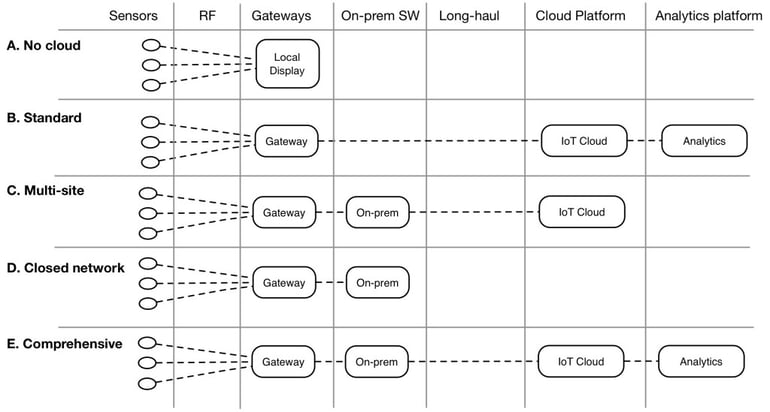IoT Strategies: Selecting Your Technology Framework
by Exosite, on July 28, 2015
In order for an enterprise to deploy a successful IoT strategy, it must create value for customers, distributors, dealers, service personnel, and users. Much of that value depends on the way in which the selected technology framework allows data to be collected, stored, and shared. Below are outlines of five connected IoT deployment patterns that should be considered in order for an enterprise to select a technology framework that best suits the needs of their connected products and delivers high value for all parties involved.
Standard:
A common IoT deployment pattern is one that includes a series of smart devices or sensors that speak to a gateway device. That gateway device relays data to an IoT software platform (denote as “IoT Cloud” in the diagram) that stores, processes, and provides views on that data. If the device is a common device such as a pump, it may also have its data routed to a backend IoT analytics solution. The information is stored and provided to select corporate divisions and personnel to analyze device performance data and failure modes.
Multi-site:
As an example of a multi-site setup, consider a chain of grocery stores that each requires IoT monitoring of refrigeration case temperature. Each store has a closed network and so requires an on-premise installation of software (denoted as Onprem” in the diagram) that can aggregate, store, and alert on temperate events within that store. On a periodic basis, that store also sends aggregate data to a centralized software instance for the entire chain of stores that allows corporate personnel to view and audit data from refrigeration cases across all stores.
Closed Network:
In instances where regulations, policies, legal liabilities, or technical limitations require that data not leave a local network, a closed-network IoT deployment pattern is required. Common examples include municipalities, medical devices, aerospace applications, convenience stores, and box-box merchants. In this pattern, devices connect (perhaps through a gateway device) to an on-premise software installation that collects, analyzes, and alerts on key events on site.
Comprehensive:
In this deployment patter, all components are activated. Devices communicate with aggregators or gatways, which store data in on-premise software installations that have a connection to an IoT cloud platform. The cloud platform is then federate with a backend analytics platform.
When selecting an IoT cloud platform for a diverse enterprise that may need differing deployment patterns across the organization, consider the following:
- Data storage and retrieval platform with open application programming interfaces (APIs)
- Flexible data schemas
- IT infrastructure hosting
- Eventing system
- Firmware over the air (FOTA) updates
- User dashboard system
- Integration with backend billing systems
- Mobile Application user interfaces
- Embedded device hardware and firmware design
For more information in regards to selecting your technology frame, download our IoT Strategies for Diversified Business white paper.





